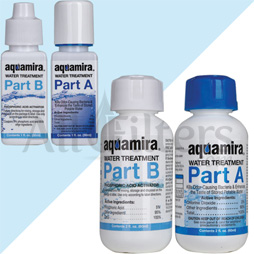When I left for Springer Mountain I thought I had my water situation down pat. Not exactly. I had used a few systems before and I had decided on carrying a Steripen Opti to treat and a Gatorade bottle to drink out of. The water would be treated in the bottle and poured into an Evernew 2L Bag for storage. I quickly realized not a week into the trail that I did not want to rely on batteries unnecessarily. The pen is great for quick treatments and all but it's just not the best for a long distance hike. The gatorade bottle is ok, but for my pack I found it cumbersome to stick it back into the side pockets after taking a swig.
Chemical treatments like Aquamira or Iodine Tablets never appealed to me on previous trips because I did not want the funny taste in my pristine backcountry water. My tune quickly changed when I saw how simple it was to mix up some Aquamira and pour it in and wait. I had no problems for about 300 miles but after awhile I could really start to taste the chemicals in my water. On top of that one of my bottles broke and was leaking without me knowing. A lot of people like Aquamira, my opinion is that it's ok. I got tired of waiting for the drops to turn yellow when stopping in for a quick top off of water. By now I had switched to using a SmartWater bottle. They are the perfect size for hikers! Tall and skinny fits in the side pockets much better and all treatments are made to purify one liter at a time. At $2 a piece it's a no brainer. One bottle would last me about 600 miles and it was replaced out of want more than need.
Then I switched to my final water treament solution. Household bleach. Yes, the same clorox you have in your kitchen is a life time supply of water purification. This is a hard concept for a lot of people to wrap there heads around. The chemical compound is what is important. Sodium Hypochlorite kills bacteria, germs and viruses. It's an ingredient found in nearly every municipal water system in the country! Chances are you have been drinking bleach all your life and never knew it. They say that it is ineffective against Crypto Sporidium however.
Bleach is hands down the simplest, most cost efficient water purification you can find. I put 2 oz of bleach into this small eye dropper and hit the trail. This much lasts about 2-3 months depending on the amount of bleach you use. I would put 2-3 drops per liter for most water sources and upped it to 4 or 5 for dirtier, stagnant water sources. Very rarely would I taste the bleach. Aqua Mira's aftertaste was always nasty. Its simple because you have to put 14 drops of chemicals per liter opposed to 2-4.
This kit is what I used for about 1600 miles. It worked flawlessly. For clear, running water, this will be in my pack. For short weekend trips and day hikes when speed is important, the Steripen will be my treatment of choice. I do not look forward to pumping water ever again. I'm taking off on a trip this weekend to hike around Lake Chicot and will have to pump all of our water. It may not be too bad but after learning what I have, it's gonna be difficult to not use this simple, effective water treatment system.
Hopefully this has given some insight into how to treat water on the Appalachian Trail or any other trip. Do your own research and find what works well for you. I have learned what I already knew, simpler is better.
I wish getting water was always this easy. A trail angel left about 50 gallons of ice water somewhere in Massachusetts.
A cold beer is almost always better than water. Another trail angel left these by a gap outside of Kent, Connecticut. We were obliged to drink them, even before 10 in the morning.






No comments:
Post a Comment